Augustynolophus
Augustynolophus is an extinct genus of herbivorous saurolophine hadrosaur dinosaur which was discovered in the Moreno Formation in California,[1] dating to the late Maastrichtian age, making it one of the last dinosaurs known from the fossil record before the Cretaceous–Paleogene extinction event.[2]
| Augustynolophus | |
|---|---|
 | |
| Holotype skull | |
| Scientific classification | |
| Kingdom: | Animalia |
| Phylum: | Chordata |
| Clade: | Dinosauria |
| Order: | †Ornithischia |
| Suborder: | †Ornithopoda |
| Family: | †Hadrosauridae |
| Subfamily: | †Saurolophinae |
| Genus: | †Augustynolophus Prieto-Márquez et al., 2014 |
| Species: | †A. morrisi |
| Binomial name | |
| †Augustynolophus morrisi Prieto-Márquez et al., 2014 | |
| Synonyms | |
|
Saurolophus morrisi (Prieto-Márquez, 2013) | |
History of discovery
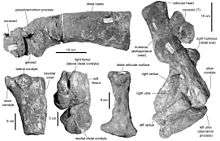
The generic name derives from a combination of the Augustyn family, who helped support the Los Angeles County Museum, and the suffix "-lophus," referring to its relation to Saurolophus. The specific name refers to palaeontologist William Morris.[3] It was originally described as a species of Saurolophus, S. morrisi.[4][5] However, when a more in-depth study took place, the end results revealed that its cranial structure was vastly different when it was juxtaposed with the other known members of the tribe Saurolophini, most notably Saurolophus osborni[6][7][8] and Saurolophus angustirostris[9][10] and Prosaurolophus maximus[11] and therefore, it was determined to be a separate genus.
All known specimens of Augustynolophus have been found only in California, which was a part of Laramidia, arguably one of the best known locations for dinosaur fossils.[12] There are currently two known specimens of Augustynolophus. The holotype, LACM/CIT 2852, was unearthed in 1943. It consisted of the majority of the skull (including the dentary and predentary), vertebrae, and bones of the limb and hand. The second specimen was designated LACM/CIT 2760. Discovered in 1939, it was made up of elements of the skull and limbs. Due to its smaller size, it may have been a juvenile.[5][13] It is one of three known dinosaurs from western coast of the United States, the other two being the Campanian Aletopelta coombsi[14] and an undescribed species of tyrannosaur from Washington state.[15] However, indeterminate hadrosaur remains have been found throughout California and similar areas.[16][17]
In September 2017, Augustynolophus was declared the official state dinosaur of California.[18]
Paleobiology
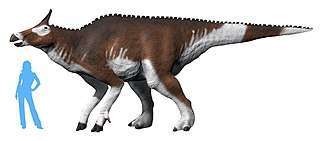
Like all species of hadrosaur, Augustynolophus morrisi was a herbivorous dinosaur which had a diet consisting of the plant life in the area, it was specialized to chew its food since hadrosaurs were one of the few known species of dinosaur that chewed its food.[19]
Paleoecology
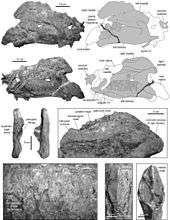
Very is little is known about the fauna found in the coastal states of Laramida,[20] which is a stark similarity to the neighboring island continent of Appalachia which was on the opposite side of the Western Interior Seaway. The western United States has a rich history of rich fossil finds, most notable examples include the Hell Creek Formation and the Two Medicine Formation.[21] However, like with Appalachia, the land fauna, most notably the dinosaurs, is not well studied and are not well known.
However, despite the fact that dinosaur fossils are rare in California, the Moreno Formation is one of the more well studied Mesozoic geological formations in California and like Appalachia, it is more well known for the large amount of marine fossils.[22][23][24][25]
References
- Sues, H.D.; Bell, P.R.; Evans, D.C. (2010). "Revision of the status of Saurolophus (Hadrosauridae) from California, USA". Canadian Journal of Earth Sciences. 47 (11): 1417–1426. doi:10.1139/e10-062.
- Lehman, T.M. (1987). "Late Maastrichtian paleoenvironments and dinosaur biogeography in the western interior of North America". Palaeogeography, Palaeoclimatology, Palaeoecology. 60: 189–217. doi:10.1016/0031-0182(87)90032-0.
- Prieto-Márquez, Albert; Wagner, Jonathan R.; Bell, Phil R.; Chiappe, Luis M. (2014). "The late-surviving 'duck-billed' dinosaur Augustynolophus from the upper Maastrichtian of western North America and crest evolution in Saurolophini". Geological Magazine. 152 (2): 225–241. Bibcode:2015GeoM..152..225P. doi:10.1017/S0016756814000284.
- Morris, W.J. (1982). "California dinosaurs". In Bottjer, DJ; Colburn, IP; Cooper, JD (eds.). Late Cretaceous Depositional Environments and Paleogeography, Santa Ana Mountains, Southern California. Los Angeles: Pacific Section, Society of Economic Paleontologists and Mineralogists.
- Prieto-Márquez, A.; Wagner, J.R. (2013). "A new species of saurolophine hadrosaurid dinosaur from the Late Cretaceous of the Pacific coast of North America". Acta Palaeontologica Polonica. 58 (2): 255–268. doi:10.4202/app.2011.0049.
- Brown, B. (1912). "A crested dinosaur from the Edmonton Cretaceous". Bulletin of the American Museum of Natural History: 131–136. Cite journal requires
|journal=(help) - Brown, B. (1913). "The skeleton of Saurolophus, a crestedduck-billed dinosaur from the Edmonton Cretaceous". Bulletin of the American Museum of Natural History. 32: 387–393.
- Bell, P.R. (February 2011). "Redescription of the skull of Saurolophus osborni Brown 1912 (Ornithischia: Hadrosauridae)". Cretaceous Research. 32 (1): 30–44. doi:10.1016/j.cretres.2010.10.002.
- Bell, P.R. (3 February 2012). "Standardized terminology and potential taxonomic utility for hadrosaurid skin impressions: a case study for Saurolophus from Canada and Mongolia". PLOS ONE. 7 (2): e31295. Bibcode:2012PLoSO...731295B. doi:10.1371/journal.pone.0031295. PMC 3272031. PMID 22319623.
- Bell, P.R. (2011). "Cranial Osteology and Ontogeny of Saurolophus angustirostris from the late Cretaceous of Mongolia with comments on Saurolophus osborni from Canada". Acta Palaeontologica Polonica. 56 (4): 703–722. doi:10.4202/app.2010.0061.
- McGarrity, Christopher T.; Campione, Nicolas E.; Evans, David C. (27 March 2013). "Cranial anatomy and variation in Prosaurolophus maximus (Dinosauria: Hadrosauridae)". Zoological Journal of the Linnean Society. 167 (4): 531–568. doi:10.1111/zoj.12009. S2CID 83747340.
- Scott D. Sampson; Mark A. Loewen; Andrew A. Farke; Eric M. Roberts; Catherine A. Forster; Joshua A. Smith; Alan L. Titus (2010). Stepanova, Anna (ed.). "New Horned Dinosaurs from Utah Provide Evidence for Intracontinental Dinosaur Endemism". PLOS ONE. 5 (9): e12292. Bibcode:2010PLoSO...512292S. doi:10.1371/journal.pone.0012292. PMC 2929175. PMID 20877459.
- Hilton, Richard (2003). Dinosaurs and Other Mesozoic Reptiles of California. University of California Press. p. 264.
- Ford, T.L. (1 October 2001). 12. Carlsbad Ankylosaur (Ornithischia, Ankylosauria): An Ankylosaurid and Not a Nodosaurid.= (1st ed.). Bloomington, Indiana: Indiana University Press. pp. 239–258. ISBN 978-0253339645. Retrieved 22 September 2016.
- Peecook, Brandon; Sidor, Christian (May 2015). "The First Dinosaur from Washington State and a Review of Pacific Coast Dinosaurs from North America". PLOS ONE. 10 (5): e0127792. Bibcode:2015PLoSO..1027792P. doi:10.1371/journal.pone.0127792. PMC 4439161. PMID 25993090.
- Morris, W.J. (May 1973). "A review of Pacific coast hadrosaurs". Journal of Paleontology. 47 (3): 551–561.
- HARPER, HILLIARD (20 May 1987). "Dinosaur Skeleton Found at Carlsbad Site". Los Angeles Times. Retrieved 24 September 2016.
- Blume, Howard (23 September 2017). "California gets its own official state dinosaur". Los Angeles Times.
- Galton, P.M. (1973). "The cheeks of ornithischian dinosaurs". Lethaia. 6 (1): 67–89. doi:10.1111/j.1502-3931.1973.tb00873.x.
- Tan, X.; Kodama, K.P. (1998). "Compaction‐corrected inclinations from southern California Cretaceous marine sedimentary rocks indicate no paleolatitudinal offset for the Peninsular Ranges terrane". Journal of Geophysical Research: Solid Earth. 103 (B11): 27169–27192. Bibcode:1998JGR...10327169T. doi:10.1029/98jb02343.
- Switek, Brian (2016-05-17). "The Dinosaurs of California's Lost World". KCET. Retrieved 17 May 2016.
- Ford, K.W. (2006). "Stratigraphic positions of marine reptile and dinosaur specimens in the Moreno Formation, in the Tumey Hills and Panoche Hills, Fresno County, California". New Mexico Museum of Natural History and Science Bulletin. 35: 407–410.
- Popenoe, W.P. (1973). "Southern California Cretaceous formations and faunas with especial reference to the Simi Hills and Santa Monica Mountains". Cretaceous Stratigraphy of the Santa Monica Mountains and Simi Hills, Southern California. Pacific Section, SEPM, Geological Guidebook, los Angeles, California: 15–20.
- Reeside, J.B. (1957). "Paleoecology of the Cretaceous seas of the Western Interior of the United States". Geological Society of America Memoirs. 67: 505–542. doi:10.1130/MEM67V2-p505.
- Stock, C. (1939). "Occurrence of Cretaceous reptiles in the Moreno shales of the Southern Coast Ranges, California" (PDF). Proceedings of the National Academy of Sciences. 25 (12): 617–620. doi:10.1073/pnas.25.12.617. PMC 1077983. PMID 16588308.

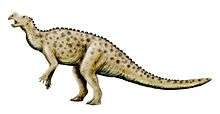

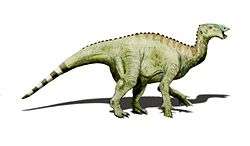


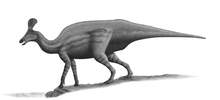
.jpg)